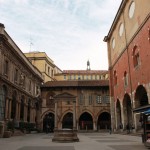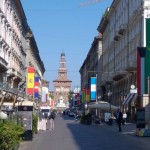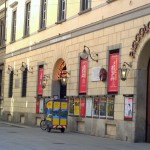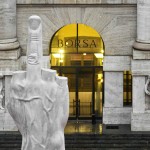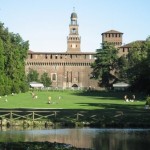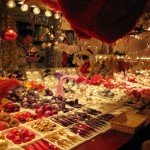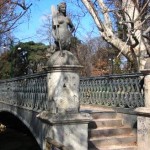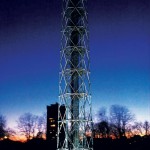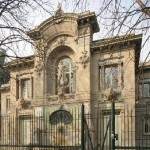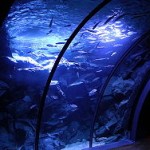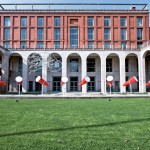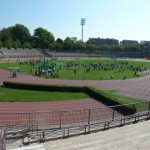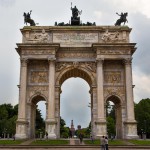From the medieval heart of Milan at Castello Sforzesco
If we find ourselves in Duomo walking along Via dei Mercanti, pedestrian, you get to Cordusio. Via Mercanti you can still see in the distance the spiers of the cathedral, but just a few steps to enter as if by magic in a discreet and secluded place that is Piazza dei Mercanti: this square is the memory of medieval Milan.
(picture by Sonia)
CURIOSITY:
The porch of the “Palace of reason” in Milan (where life was once the ancient city of Milan and where trade and economic activities developed) as well as hosting the “Scrofa semilanuta” in one of its capitals, offers an absolutely extraordinary acoustic effect, similar to the Ear of Dionysus, known to local people as the “Milan Phone.” Placing itself within the colonnade, with their faces turned toward the column that is the outer corner of the building, towards the Cathedral (pictured is the one with the white plate) you can talk to that ‘other people placed on the diagonal of the first quadrilateral columns, also facing the inner wall of the own column.
Just a few meters further and the scenery changes again:
from Piazza Cordusio part via Dante, a pedestrian area since 1996, enlivened by local, shops, exhibitions and open-air exhibitions. From here you can already see on the horizon the majestic Castello Sforzesco, not to forget, in a small side street the Teatro Grassi with its splendid cloister.
Instead of P.za Cordusio and Via Meravigli an even different place:
Piazza degli Affari that, the wall street in Milan. Piazza degli Affari, built between 1928 and 1940 on an area that was home to the early Middle Ages the Mint, has accounted for up to 90 years the financial heart of the city for the presence of the stock exchange and the market “shouted.”
Palazzo Mezzanotte is the palace that dominates as a theatrical Milan’s Piazza Affari is a significant example of architecture the thirties of last century. The whiteness of the marble, the imposing columns, sculptures on the top give the complex a symbolic feast at the temple of the Italian stock market. The place of negotiation of the shares, now emptied of a time, the screams, the physicality of the negotiation confined today on digital platforms, however, remains a meeting place, conventions, presentation of reports of market regulation authority, or meetings for the launch of the listing on the Italian market for new titles.
L.O.V.E., commonly known as “The Finger” is a sculpture placed in the center of Piazza degli Affari, Milan, Italian artist Maurizio Cattelan. The work is placed in front of Palazzo Mezzanotte, home of Borsa. The name is an acronym for “freedom, hatred, revenge, eternity.” The sculpture is 4 meters high and 60, which become 11 total counting the base, and is made of Carrara marble.
The work depicts a hand intent in the fascist salute but with all fingers chopped off–as if eroded by time-except the middle finger. The gesture irreverent, contrasted ironically with the classic style and monumental opera, seems so contact both the architecture of two decades of Palazzo Mezzanotte in the world of finance that it represents
FROM CASTELLO SFORZESCO AT ARCO DELLA PACE
FROM SEMPIONE PARK
Castello Sforzesco
Great symbol of Milan Sforza, il Castello Sforzesco it is the most important defensive monument in the city. Expanded between the fourteenth and fifteenth centuries, it is rebuilt with square shape and four corner towers at the behest of Francesco Sforza (1450-66). After his death is transformed into a magnificent palace.
In the most prestigious areas – the Place d’Armes, the ducal court with Portico of the Elephant, the Rocchetta and Ponticella – have taken the most important artists of the time, including Leonardo and Bramante.
(picture by Sonia)
The Castle, however, is not only a testimony of the past but also a cultural center, saw that welcomes some of the civic museums of milan. Also on the occasion of the patronal feast, December 7 (St. Ambrose), the area is home to the stalls of the so-called
“Fiera degli Oh bej! Oh bej!”.
Stalls of the Fair ” Oh bej! Oh bej!” (it means “Oh nice, Oh nice)
Sempione Park: not only green
Sempione Park is the green lung in the heart of Milan. It is also a gateway to the center, through the Castello Sforzesco. The things to do in this beautiful park in the heart of Milan ranging from:
Arena Civica , at Arco della Pace, from Triennale at Torre Branca and l’Acquario Civico di Milano .
With the chance to do two steps also in Chinatown.
The park covers an area of 40 hectares along the route that leads from the Cathedral at Simplon pass through the Arco della Pace.
Made in the 1890s and designed by Emilio Alemagna, it hosted the International Exhibition pavilions of 1906 (EXPO OF 1906) and is the park in Milan today par excellence, much frequented by sportsmen and families especially weekends. It is not, however, only the green lung of the city, but a place that tells the history of Milan’s past. On the inside, for example, it is of the Sirenette Bridge, so named for the four statues that characterize it. Made in Dongo ironworks in 1842, it is considered the first metal bridge built in Italy.
CURIOSITY :
Today used by young people to promise themselves eternal love, attacking the famous locks of love.
Sirenette bridge (mermaids bridge)
(picture by Sonia)
Another story is that of the fountain of the ” putrid water “, in the past considered a cure-all for the health thanks to its sulphurous properties.
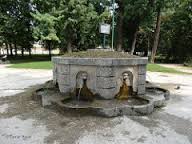
From the park you can have an amazing panoramic view of the city, climbing the Torre Branca (Branca Tower 108.60 m high), commissioned in 1932 by the Comune di Milano ( City of Milan). Designed by Gio Ponti and assembled in just two and a half months of work, it was inaugurated at the Fifth Triennale (1933).
At the foot of the Torre Branca, is the restaurant “Just Cavalli” meeting place for young fashionistas.
Another attraction located in the park is the Acquario Civico (Civic Aquarium), the only building left of those made in Milan on the occasion of International 1906. After restoration, completed in 2006, the interior space includes educational exhibition paths and research, with numerous pools of fresh and marine water containing more than a hundred species of aquatic organisms.
The park is home, finally, also a public library a bit ‘special: its architecture has been awarded the Gold Medal at the Tenth Triennial in 1954.
Triennale Museum Milan
Another symbolic place – which projects with its initiatives the city internationally – is the Foundation La Triennale di Milano, an institution for architecture, urban planning, design, decorative and visual arts, crafts, fashion , industrial and audiovisual production. The interior houses exhibitions rotating themes; on the ground floor leads to the Architecture Gallery, designed by Gae Aulenti in 1994 and dedicated to temporary exhibitions. In 2007, of the architectural design by Michele De Lucchi, the Triennale Design Museum was inaugurated, presenting every year a different set-up, changing the subject and curator.
Another place of attraction to a few tens of meters is the Arena Civica (Civic Arena) – designed by Luigi Canonica built in 1806 with materials from the demolition of the fortifications of the Castle) which hosts sporting events, concerts and cultural events.
CORSO SEMPIONE AND ARCO DELLA PACE
Leaving the Sempione Park in north-west direction, you find yourself in front of one of the most important neo-classical monuments of the city: the Arco della Pace, built starting in 1807 and designed by Luigi Cagnola. Together with two toll daziari, it is the final head of the Sempione road, built in the Napoleonic time to connect Milan and Paris. In recent years, especially in the immediate vicinity of the Arco della Pace, were born a number of commercial and catering activities which have made it an important center of Milan’s nightlife, to spend the evening with friends in joy, in dozens of venues around the Arco della Pace.
SUMMARY
1)FASHION DISTRICT AND HISTORICAL CENTER
2)FROM THE MEDIEVAL HEART OF MILAN TO THE CASTLE
3)TICINESE DISTRICT AND NAVIGLI
4)FROM BRERA TO CORSO COMO
5)PORTA NUOVA DISTRICT AND ISOLA DISTRICT
6)CHINATOWN
7)OTHER DISTRICTS: sports district, Bicocca district
8)THE PARKS
